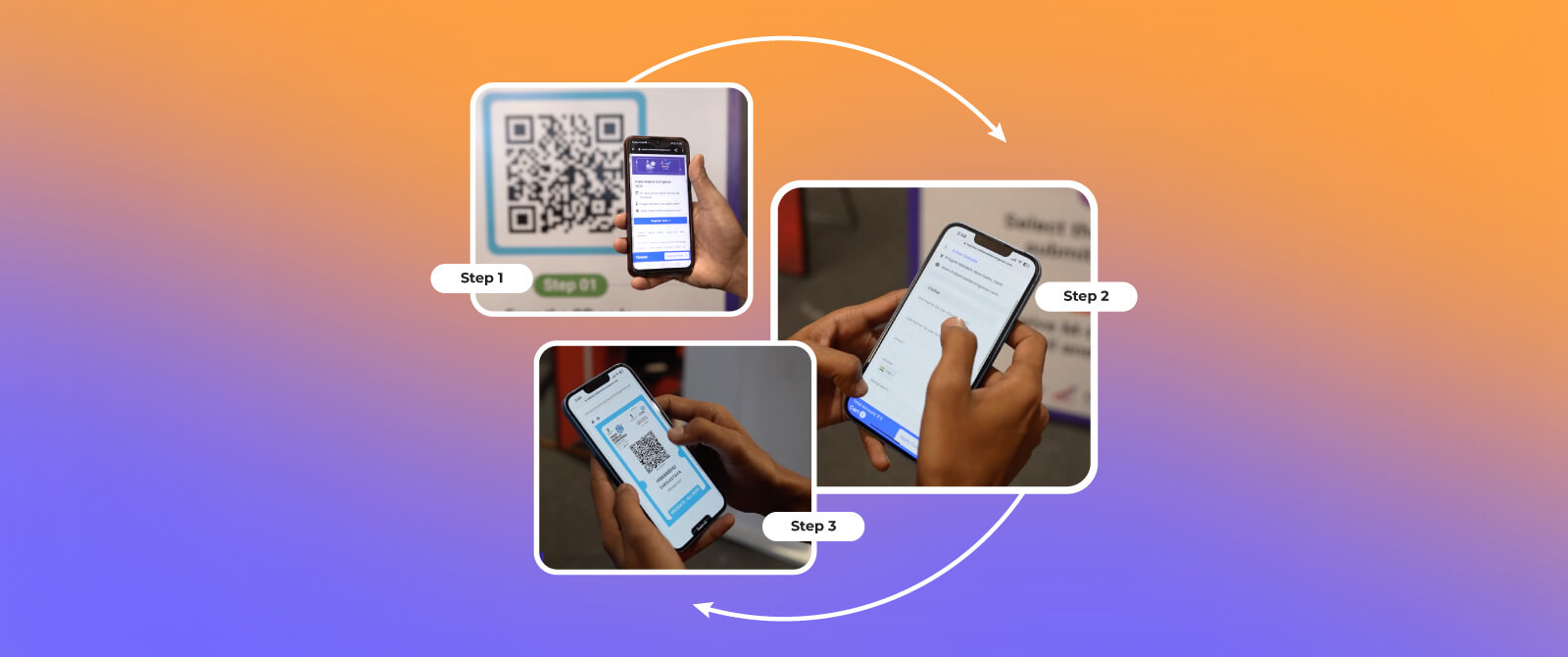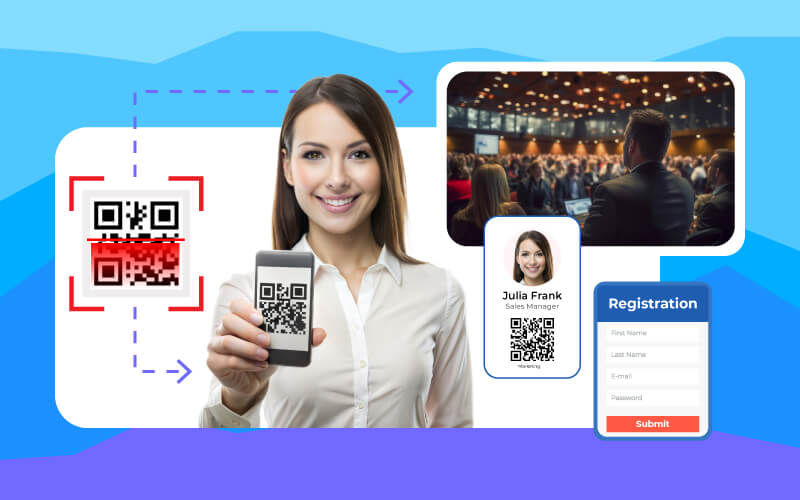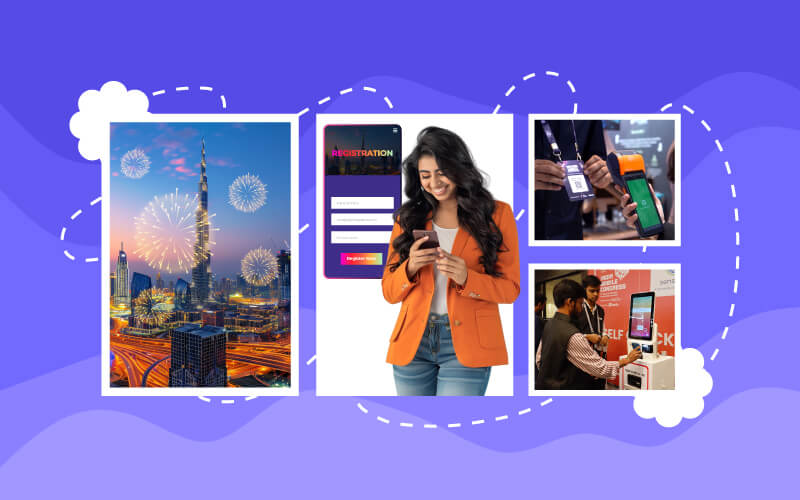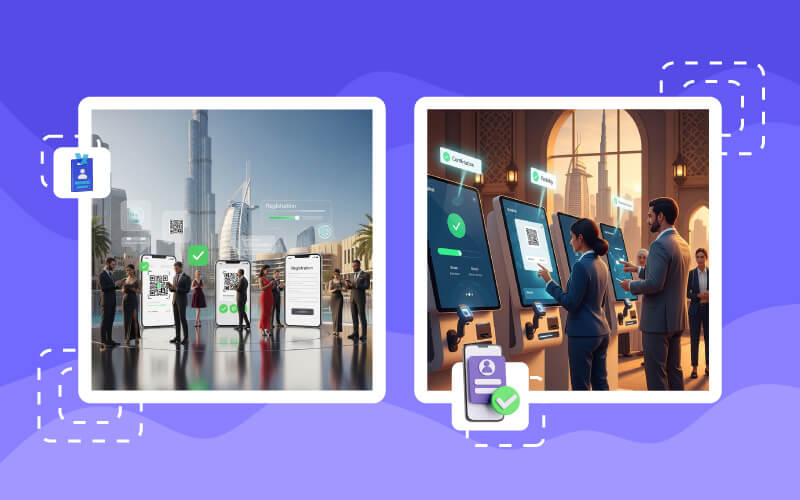Do you want to learn about QR code best practices? Tired of long registration lines and chaotic check-ins? QR codes are your event management savior. This blog reveals QR code best practices to streamline entire events, from small gatherings to large conferences. Discover how to enhance attendee experiences with us, boost efficiency, and gather valuable data. Let’s transform events with the power of QR code integration for seamless experiences.
10 Recommended QR Code Best Practices in Event Registration and Check-In
Let’s delve into key strategies for effective QR codes for event registration and check-in.
Practice #1: Ensure QR Code Readability

The very first QR code best practice starts with a crucial check on the quality of the QR codes when scanning during event check-in to avoid issues. Here’s what needs to be checked with the QR code event check-in.
- High Resolution: QR codes for event registration should be generated at a high resolution to ensure clarity. For example, at a large tech conference, high-resolution QR codes on event badges ensure that QR scanners can easily read them from a distance.
- Design Simplicity: Avoid intricate designs that might interfere with scanning. For instance, in a corporate seminar, a simple, clean QR code without excessive decorations or colors ensures fast and accurate scanning.
However, being prepared with key QR best practices in advance can save the event professionals from potential scanning problems that arise on the event day. Let’s find out how to handle:
- Varied Devices: Test QR codes for events with different smartphones and scanning apps to ensure compatibility. At a music festival, checking QR codes on various devices helps avoid issues when attendees use their phones to enter the venue.
- Error Checking: Ensure the QR code event check-in links correctly to the intended page. At a trade show, double-check that QR codes event badges direct exhibitors to their booth setup instructions without errors.
Practice #2: Optimize QR Code Placement for Effective Event Registration
From future marketing insights, it was found that the global QR code label market is anticipated to register US$ 3.5 billion by 2033, advancing at an 8.7% CAGR from 2023 to 2033. For seamless QR code event registrations, strategic placement of QR codes making it easy for attendees to find and use them. Therefore, focus on prioritizing:
- Prominent Locations: Place QR codes on event tickets, confirmation emails, and signage. For a sports event, QR codes on tickets should be easy to locate for quick entry at stadiums.
- Event Materials: Include QR codes on promotional materials. During events like charity galas, QR codes should guide attendees to the event registration page efficiently by using flyers and social media posts.
Moreover, ensure providing clear and straightforward instructions to help attendees understand how to use QR codes without confusion.
Practice #3: Integrate with a Reliable Platform for QR Code Usage
According to a survey, the United States leads worldwide in QR code usage, with a total of 2,880,960 million scans. Picking up the right QR code service provider can make a significant difference in handling QR code data smoothly in large events like trade shows, exhibitions and expos. Keep all these QR code best practices in mind:
- Seamless Integration: Opt for a platform that integrates effortlessly with QR code technology to streamline check-in. For example, using a platform like Dreamcast ensures that QR code scans sync with real-time databases at large conventions, speeding up entry.
- Real-Time Updates: Ensure your system provides instant updates to manage attendee data effectively. During a product launch, this prevents delays and helps manage crowds efficiently.
- Efficient Processing: Select a system capable of handling high volumes of scans smoothly. At trade shows, this minimizes wait times and keeps the check-in process swift.
- Enhanced Attendee Experience: Quick and efficient check-in through QR codes for events that reduces waiting times and improves overall satisfaction. For instance, at events like Outbound Travel Mart (OTM) 2024, attendees benefit from a seamless experience of moving effortlessly between booths and sessions.
- Organizer Efficiency: An integrated QR code system simplifies data management, allowing for real-time tracking and reporting. This helps event organizers manage operations more smoothly and address issues promptly.
- Improved Security: Use platforms that provide unique QR codes to prevent duplication and fraud, ensuring secure and reliable event access.
Practice #4: Provide Multiple Check-In Options Using QR Codes
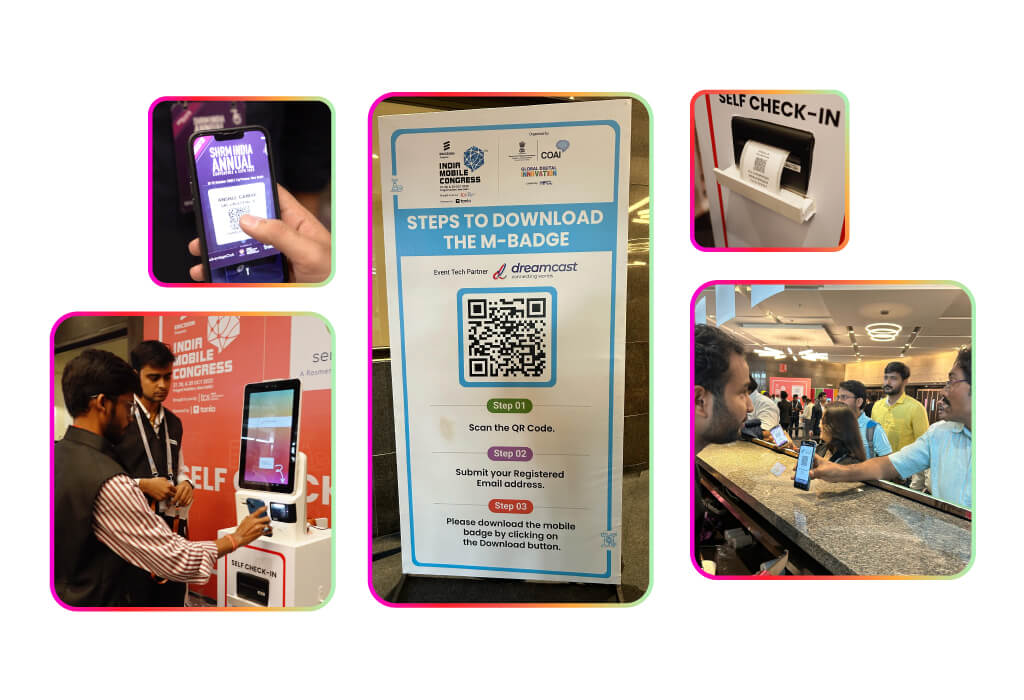
Another best practice to consider while QR code integration is to offer self-service options that can speed up the event registration and check-in process. Here’s what needs to be done:
- Ease of Use: Set up self-kiosk stations where attendees can scan their QR codes. For instance, at a music festival, self-check-in kiosks should be placed at multiple entry points for quick QR code scanning of event tickets and easy entry access. This setup will reduce wait times and streamline entry, allowing festival-goers to start enjoying the music and activities sooner.
- Staff Assistance: Having trained staff available ensures that any issues with QR code scanning are quickly addressed. In the case of large conference events, a few attendees might get confused and struggle with the unfamiliarity of QR code technology or technical glitches. But, with staff members stationed at check-in areas, attendees can get immediate guidance and a stress-free entry process.
- On-Hand Help: For events where attendees might face difficulties with QR codes, having staff available for assistance is crucial. For instance, at a large academic conference, onsite staff can guide attendees through the QR code usage and scanning process. This support is particularly valuable for those attendees who may not be tech-savvy or encounter problems with their QR code event check-in.
Practice #5: Ensure Data Security with QR Code Integration
To maintain the trust and security of attendees, it’s crucial to protect attendee data. Follow the below-mentioned QR code best practices to prevent any fraud;
- Secure Transmission: Use encryption to protect attendee data from unauthorized access. For high-profile networking events, the best practice for QR codes is to use encryption, which safeguards personal information shared through QR codes from potential breaches with protocols like transport layer security (TLS) and secure sockets layer (SSL).
- Privacy: Being transparent about data in QR code usage helps build trust with attendees. Therefore, provide clear and straight privacy notices at registration points and on your event website. Include details on how attendees’ data will be collected, used, and protected.
- Clear Policies: Inform attendees about how their data will be used. Create data protection policies that are easily accessible by including links to them in registration confirmations and event materials. For events like health and wellness seminars, transparency about data usage builds trust and ensures compliance with privacy regulations. Besides this, obtain explicit consent from attendees before collecting or processing their data.
- Data Minimization via Registration Forms: Collect only the data necessary for event management and avoid gathering excessive personal information. For example, at health and wellness seminars, limit data collection to what is needed for the event and avoid storing sensitive health information unless necessary.
Read More: Tips for Event Registration Forms
Practice #6 Design for Accessibility with QR Codes
Ensure that QR code integration provides easy visibility and is readable to all attendees. Let’s consider these effective tips:
- Readable Design: Ensure QR codes for events have high contrast and are large enough for easy scanning. For instance, at the Serendipity Arts Festival, QR code integration assisted organizers in easing attendees with visual impairments to access information without difficulty.
- Alternate Methods: Providing backup options ensures that everyone can check in smoothly, regardless of their familiarity with QR codes. Consider manual check-in, facial recognition, turnstile access, mobile event apps, etc.
Practice #7: Monitor and Analyze QR Code Usage
Analyzing scan data can be another best practice for QR codes, as it provides valuable insights into event flow and attendee behavior.
- Real-Time Analytics: Monitor QR code scans to gather insights. In events like trade fairs, tracking scans can reveal peak entry times and help adjust event staffing levels for optimal efficiency.
- Feedback: Gathering feedback helps improve the process for future events.
- Continuous Improvement: Collect feedback on the QR code check-in process. After a charity run, asking participants about their experience with QR codes helps refine future events.
Practice #8: Prepare for Technical Issues with QR Code Integration
If plan A fails, be prepared with plan B. Having contingencies in place ensures that any technical problems or event registration challenges don’t disrupt the event. Let’s know about what can happen;
| Technical Issue | Description | Potential Impact |
| Scanning Issues | Problems with reading QR codes due to low resolution or poor lighting. | Difficulty in scanning, delays, and user frustration. |
| Integration Problems | Issues with compatibility between QR code systems and event management software. | Data synchronization problems, and operational delays. |
| Data Security Concerns | Risks associated with unencrypted data transmission or fraudulent codes. | Unauthorized data access, and security breaches. |
| User Experience Challenges | Complications from complex QR codes or unclear instructions. | Confusion, slow check-in, negative attendee experience. |
| Technical Failures | System downtimes or software bugs affecting QR code functionality. | Disruptions in event registration and check-in. |
| Network Issues | Connectivity problems or bandwidth limitations affecting QR code processing. | Slow response times, and processing delays. |
To conquer all these problems, it’s crucial to have a backup QR check-in system ready. Ensure backup methods like manual check-in or offline QR code readers that can handle unexpected technical issues. Also, a dedicated technical support team can also help in addressing problems swiftly and keeping the event running smoothly.
Read More: 9 Most Common Technical Problems at Events and How To Fix Them
Practice #9: Use Dynamic QR Codes for Flexibility
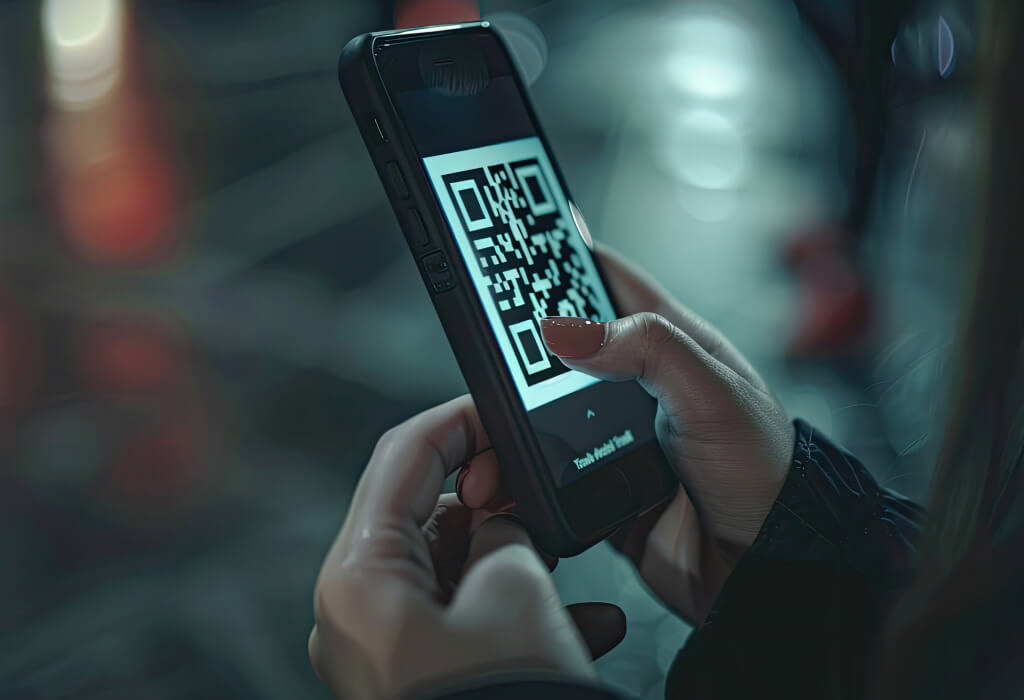
Dynamic QR codes can be edited after creation and they offer flexibility for last-minute changes in the event registration process. Here’s what needs to be considered:
- Content Updates: Use dynamic QR codes to direct attendees to updated event information or schedules. If there are changes to session times or locations, dynamic QR codes can be updated without needing to reprint or redistribute materials. Dynamic QR codes can also track user interactions, providing valuable insights into attendee engagement.
- Behavior Analysis: Track how often and where QR codes are scanned. Event organizers can adopt this QR code best practice to analyze the scanned data and understand which promotional materials are most effective and where attendees are engaging the most.
Practice #10: Enhance Engagement with Interactive QR Code Features
Lastly, use QR code integration to unlock interactive experiences, as it’ll add value beyond simple check-ins. According to the Statistica, In 2022, around 89 million mobile device users engaged with QR Codes, marking a 26% increase from 2020. This figure will rise to 100 million. by 2025. Let’s know how.
- Exclusive Content: Provide access to exclusive content or interactive features. Leverage QR codes on tickets to unlock behind-the-scenes footage or exclusive interviews with filmmakers.
- Gamification: Incorporate gamified elements such as scavenger hunts or interactive challenges. Gamification involves applying game-like elements to non-game contexts to encourage participation and make activities more enjoyable. By integrating gamification into your event using QR codes, create interactive and engaging experiences that captivate attendees.
- Event Engagement: Create a QR code-based scavenger hunt where attendees collect virtual event badges or rewards. For instance, at a tech expo, attendees could scan QR codes at different booths to earn points and win prizes, which will make the event more engaging and fun.
Read More: 35+ Event Gamification Ideas
Here’s the complete table showing each category of QR best practice with their considerations
QR Code Integration for Seamless Event Management
| Category | Recommendation | Details |
| Choose the Right QR Code Solution | For Effective QR Code Integration | Select a reliable QR code solution with features for easy generation and scanning. Customization options enhance branding. |
| Ensure Compatibility with Scanning Devices | For Smooth QR Code Usage | Test QR codes with the devices used at your event to avoid scanning issues. |
| Customize QR Codes for Branding | Incorporate QR Code Integration | Customize QR codes with logos or themes to enhance brand visibility and reinforce event identity. |
Best Practices for QR Code Based Event Registration
| Category | Recommendation | Details |
| Use Dynamic QR Codes | For Optimal QR Code Usage | Use dynamic QR codes to update content linked to the code without reprinting. |
| Test QR Codes Before the Event | Ensure Effective QR Code Integration | Conduct thorough testing across devices and apps to identify and fix issues. |
| Provide Clear Instructions for Attendees | To Enhance QR Code Usage | Offer clear, simple instructions on using QR codes through various mediums like guides, apps, or signage. |
| Ensure Quick and Easy Access | For Smooth QR Code Event Check-In | Make QR codes easily accessible via email or event apps for efficient check-in. |
Implementing QR Code for Event Check-In
| Category | Recommendation | Details |
| Real-Time Validation | For Effective QR Code Event Check-In | Implement systems to instantly validate QR codes and manage attendance efficiently. |
| Provide Backup Check-In Options | For a Smooth Event Experience | Offer alternative check-in methods, such as manual options or support staff, to assist with QR code issues. |
Additional Tips for QR Code Integration
| Category | Recommendation | Details |
| Use High-Quality Printing | For Enhanced QR Code Usage | Ensure QR codes are printed clearly to avoid scanning difficulties. |
| Regularly Update QR Code Links | For Effective QR Code Integration | Frequently review and update linked content to keep information current. |
Summing Up:
In conclusion, we have covered the 10 QR code best practices that are revolutionizing how we manage event registration and check-in. By following these best practices—event organizers can ensure readability, optimize placement, integrate with reliable systems, provide multiple check-in options, and incorporate dynamic and interactive features. Whether you’re organizing a high-profile conference, a local community event, or a large-scale festival, QR code integration can make the process smoother and more efficient. So, don’t sit and wait, embrace these QR code best practices to leverage QR code usage effectively and deliver a seamless event experience for all participants.



